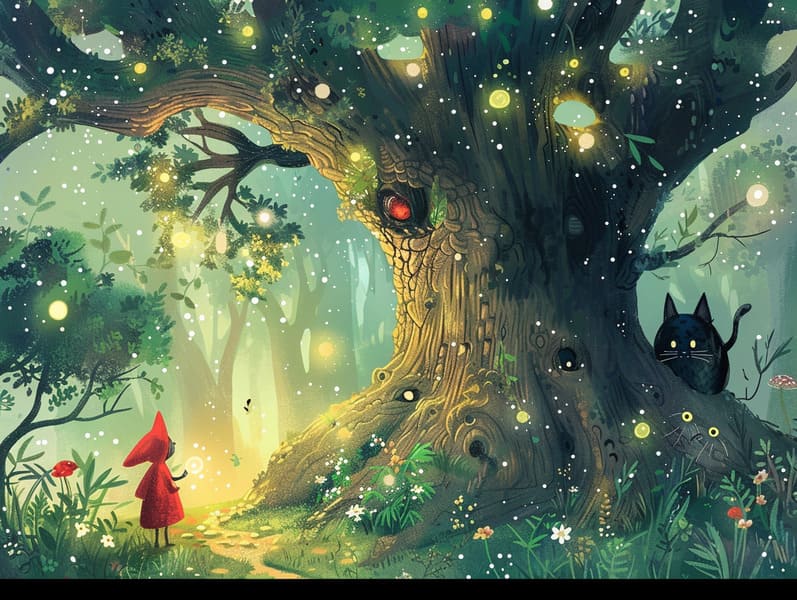
Ancient fairy tales have deep roots. These stories have been passed down from one generation to the next ages before they were ever recorded. They came from a variety of cultures, including Middle Eastern traditions. They were initially narrated among older generations, often carrying themes and messages mirroring the societal norms and beliefs of the time.
The renowned Brothers Grimm, Jacob and Wilhelm, were among the first to gather many of these beloved stories. Their published works, "Grimm's Story Collection," included stories like "The True Bride," "The Bread Crumb Trail," and "Snow White," which have since become staples in the world of traditional fairy tales. Similarly, H. C. Andersen's fanciful tales, such as "The Sea Maid," and "The Duckling that Could," have captivated hearts worldwide, solidifying their place in the pantheon of famous fairy tales.
Though they are old, traditional fairy tales remain as pertinent as ever, especially as nighttime stories for kids. These delightful tales are now available in numerous formats, including vibrantly illustrated books, captivating animations, and internet fairy tales.
Their persistent charm can be linked to several delightful features:
Significant Morals: Ancient fairy tales often convey important moral lessons. Stories like "The Wolf and the Liar" teach the virtue of honesty, while "The Tale of the Tortoise and the Hare" highlight the traits of perseverance and unassuming nature. These tales offer young ones clear distinctions between virtue and vice, building their moral compass in a gentle yet meaningful way.
Empathy and Awareness: Traditional fairy tales frequently showcase characters facing difficulties and adversities, fostering young listeners to empathize with their struggles and encourage their triumphs. For instance, "The Story of Beauty and the Beast" points out the virtue of looking past the exterior to recognize the real person of a character, strengthening sympathy and appreciation.
Cultural Recognition: Many timeless fairy tales are deeply embedded in the cultural contexts from which they bloomed. Exploring these narratives can provide fascinating glimpses into different historical contexts, fostering a sense of cultural appreciation and discernment.
Inventiveness and Imagination: The fantasy-filled elements in traditional fairy tales—magic wands—revitalize children’s innovations. These narratives carry readers to mythical realms, kindling innovative dreams and a sense of delight that continues a lifetime.
Ancient fairy tales are not only captivating but also instructive. They act as whimsical tools in building various cognitive and affective skills in young readers. When old fairy tales are voiced, they nurture language proficiency by presenting new phrases and sophisticated sentence structures. This practice also promotes auditory skills and mental focus, as the young concentrate deeply, keen to see what happens next.
Furthermore, talking about the themes and characters of traditional fairy tales can cultivate intellectual skills and intellectual skills. Kids are led to discern patterns, predict happenings, and realize cause and effect. These reflections also facilitate the young say their thoughts and feelings, promoting their emotional intelligence.
In today’s digital era, the proliferation of digital fairy tales has made these narratives more attainable than ever. Websites and apps share huge assortments of classic fairy tales that can be accessed or heard anytime, anywhere. Fairy tales spoken are particularly widespread, providing an interactive way for young readers to experience these charming stories. Read-aloud stories and spoken videos bring characters and settings to life, often paired with whimsical melodies and musical scores that improve the narrative adventure.
The timeless fascination of traditional fairy tales lies in their ability to transform to modern times while sustaining their central messages. Contemporary renditions of these fairy tales often show more representative protagonists and modern settings, making them pertinent to today’s audience. However, the central morals of courage, warmth, and fairness remain unchanged, continuing to affect readers of all ages.
Traditional fairy tales also offer a sense of protection and comprehensibility. They present to a well-structured narrative with a unmistakable beginning, middle, and end, often coming to a close with the resolution of conflicts and the triumph of good over bad. This assuredness can be reassuring for young ones, bringing a sense of invariability in an unstable world.
Classic fairy tales continue to enthrall and edify new generations, maintaining their grace and impact in modern society. As nighttime stories for kids, they present a perfect blend of enchantment and education, enriching moral values, empathy, and creativity. The accessibility of digital storybooks and the popularity of read more fairy tales recited promise that these old stories remain acquirable to new generations.
By perpetuating and relating these tales, we continue to treasure the rich tapestry of inventiveness and cultural heritage. Whether you are delving into a vibrantly illustrated book, perusing a online library, or listening to an sound book, the appeal of famous fairy tales is always within reach. These narratives illustrate of the steadfast effect of stories and its ability to gather us across epochs and places.
Regardless if you are reading a richly illustrated book, exploring a electronic library, or listening on an read-aloud book, the fascination of traditional fairy tales is always within reach.
These fairy tales highlight of the steadfast spell of narratives and its ability to link us across time and space, creating a bond that delights and instructs alike.